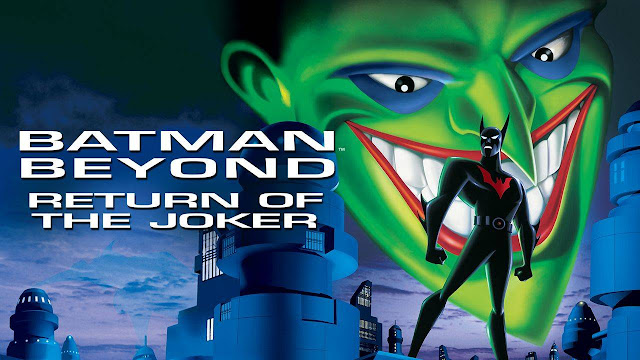PHENOMENALITY: *marvelous*
MYTHICITY: *fair*
FRYEAN MYTHOS: *adventure*
CAMPBELLIAN FUNCTION: *psychological*
(Note: the version I'm reviewing is the uncut version of the DTV film, released two years after the original 2000 release, which had been cut in response to the catastrophic Columbine shootings.)
I don't think the Timm-Dini Bat-verse ever managed to create any interesting new myths in BATMAN BEYOND. As I recall, it was just a good basic formula-series, based on the premise of what sort of successor an aging Batman might choose, about fifty years down the road from "Batman in his thirties." Given that even gritty Gotham gets something of a JETSONS-style makeover, New Batman Terry McGinnis wears a high-tech armored suit (which furnishes him with an Iron Man-like arsenal in place of a humble utility belt) and even allows him to fly on mechanical bat-wings.
For the most part the 1999-2001 series eschewed the use of established Bat-rogues. However, the most famous one might have been absent, but he left the greatest legacy of any villain, for in McGinnis's time roving bands of rowdies called "Jokers" roam the mean streets. For this 2003 DTV release, though, the producers arranged a face-off between New Batman and a villain who both is, and is not, the original Joker.
The apparent return of the Clown Prince of Crime is fittingly heralded by the depredations of a new band of formidable Joker-hoods, who are possibly the best-designed villains of the BEYOND-verse, given that they all have a strong carnivalesque vibe. The two with the greatest links to the original Harlequin of Hate are twin, clown-faced acrobats, both called DeeDee, who are implicit imitators of Harley Quinn (and who turn out to be descendants of the original Harley). After New Batman has an initial battle with these goons, both he and Old Bruce Wayne get attacked in such a manner as to suggest that their enemy knows both of their costumed identities. And then a being who seems a dead ringer for the Joker appears. Problem is, the Joker is supposed to be dead, and both Batman and Batgirl witnessed his demise fifty years ago.
There's a long segue as Old Barbara Gordon (now the police commissioner in Neo-Gotham) tells a harrowing story as to how the Joker kidnapped the Tim Drake Robin and subjected him to a personality-changing torture. The attempt backfires on Joker and causes his death, but this proves a measured victory, given that the horror casts a shadow over the lives of all those involved, including Tim, who matured into a family man and put aside the childish life of the costumed hero. Terry suspects a link between the dead villain and his former victim. Yet the detection aspect of the story proves less central than the struggle between Old Batman and New Batman, as the latter tries to live up to the Bat-legacy while the former tries to shield the younger man from harm.
The solution to the Joker's re-appearance is far-fetched even for a comic-book adventure, but the climactic battle between New Batman and New Joker is well-done. I don't buy any of Terry's attempts to psychoanalyze the Joker in mid-fight, but the gimmick is at least memorable. And while there will never be a final Joker story for the modern Batman as long as the franchise lasts, the Last Joker Story in the universe for New Batman carries its own cachet.


No comments:
Post a Comment